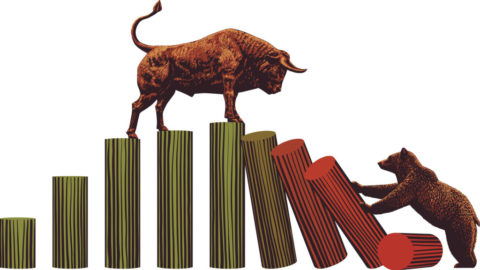Rates, Recessions, and Bears… Oh My!
Heads Up & Eyes Ahead for 2023
By: Steven Higgins, Financial Advisor, Principal
We’ve made it through the first month of 2023 and as far as I can tell, the sun continues to rise. It’s now been over one year since we began the stock market correction in which we remain. The volatility of the last 13 months has had everything to do with fears of what the consequences might be if the Federal Reserve Board of Governors, led by the Fed Chair Jerome Powell, goes too far in their effort to curb high inflation by employing more strict monetary policy, mostly by increasing the Fed Funds Target Interest Rate.
“Hold My Beer”
After the Federal Open Market Committee (FOMC) meeting in May, 2022 the Fed increased the Fed Funds Rate by .50%. After the announcement in his article, How Aggressive Will The Federal Reserve Tighten Monetary Policy? Jordan Jackson, Global Market Strategist for JP Morgan wrote, “Chairman Powell ruled out the possibility of a larger 75 basis point increase, which may have comforted investors fearful the committee would be overly aggressive in tightening policy.” He followed, “To be clear, we expect .50% increases at the end of the June and July meeting, and for further .25% increases thereafter suggesting a Fed Funds target range of 2.50-2.75%” Well, the Fed Chair Powell and his cohort of Fed Governors proceeded to wow everybody in a truly economic “hold my beer” moment as they followed with four straight .75% increases to the Fed Funds Rate plus a .50% increase in December for good measure bringing the Fed Funds Target Rate to 4.25 – 4.5% nearly double JP Morgan’s estimates in May.
So, we didn’t just get the “nightmare scenario” we got the nightmare and then some extra nightmare. Some might have predicted stock market implosion and investor panic as the flames of recession were errantly stoked by a hawkish Fed raising rates at a blistering pace. Well, that simply hasn’t, to this point been the reality. While volatility has persisted with the stock market measured by the S&P 500 first crossing the -20% threshold in late May of 2022 making this correction officially a Bear Market. Stocks attempted a Summer comeback only to be derailed by the ever present buzz kill and least cool person in school, the Fed. Stocks, recorded, what so far has held as this correction’s market bottom of -26% on October 12, 2022. So, while negativity certainly ruled 2022, the last several months have shown us an orderly market response to what has been increasingly positive signals that the battle against rampant inflation has been successful or at least the rate of inflation is falling and the Fed has signaled a willingness to consider less drastic actions. This was first exampled by the Fed increasing the Fed Rate after the December meeting by “only” .50% instead of a fifth straight increase of .75%. The consensus for February’s meeting of the Fed is that the Fed Funds Rate will be increased by .25% with similar increases continuing over the next several meetings. There are musings of the Fed halting increases in short time, but conflicting economic data makes that prophecy challenging.
Positivity is Being Dampened by Recession Fears
So here we stand just over a year since we started the bear market dance and we find ourselves having survived worse than was feared possible as it relates to the Fed’s inflation responses. Inflation itself has decreased considerably and in response the stock market (S&P 500) is up 15% from the October low and showing meaningful enthusiasm to start 2023 coming out of the gate with an initial gain of over 6% so far in January. So if inflation is moderating, the Fed is showing signs of backing off, and the economy judged by recent, strong economic data is showing remarkable resiliency, why the continued trepidation? The palpable skepticism we sense is like a fog making the sun hard to see and feel. We’ve been told that all of this tightening of monetary policy is going to lead us into a RECESSION! It’s like the fuse has been lit and we all wait for the inevitable. And so we wait for all things recession. This waiting for the shoe to drop contributes to a sort of paralysis. To be fair, I think many took for granted the simplicity in the definition of what actually is a recession. In short, there is no actual definition of a recession. Let’s start with the following excerpt from the website for the government’s Bureau of Economic Analysis (BEA.GOV).
“In general usage, the word recession connotes a marked slippage in economic activity. While gross domestic product (GDP) is the broadest measure of economic activity, the often-cited identification of a recession with two consecutive quarters of negative GDP growth is not an official designation. The designation of a recession is the province of a committee of experts at the National Bureau of Economic Research (NBER), a private non-profit research organization that focuses on understanding the U.S. economy. The NBER recession is a monthly concept that takes account of a number of monthly indicators—such as employment, personal income, and industrial production—as well as quarterly GDP growth. Therefore, while negative GDP growth and recessions closely track each other, the consideration by the NBER of the monthly indicators, especially employment, means that the identification of a recession with two consecutive quarters of negative GDP growth does not always hold.” (BEA.GOV)
In the explanation, the National Bureau of Economic Research (NBER) is referenced as the deciding authority of what or when is a recession. The NBER is a non-profit “committed to undertaking and disseminating unbiased economic research among public policymakers, business professionals, and the academic community.” (NBER.org) In a September 22, 2022 article in Forbes, When Will This Officially be Called a Recession, further explanation of the NBER’s process is explained, “A recession is a period of significant economic decline lasting more than a few months, according to the NBER. However, the bureau relies on more than just one measure to make that call, such as GDP growth. Instead, it looks at the economy as a whole, weighing factors such as real personal income (RPI), employment, consumption, retail sales and production.” And lastly, my favorite part; the author continues, “The NBER also says there is “no fixed rule about what measures contribute information to the process or how they are weighted in our decisions.” In other words, every set of economic conditions is different, and there is no specific threshold that must be met before a recession is declared.”
Take a deep breath, and let your brain stop trying to care about what you just read. Here are my takeaways:
- There is no fixed rule about what measures contribute to the process.
- There is no specific threshold that must be met before a recession is declared.
…Says the organization who decides.
So, the media fixation and consequently, investor paranoia, is focused on something that I can’t define-you can’t define. There is no definition of the thing that they will at some point let us know was a recession. I say “was” a recession because economic data is backward looking and periods that have been later called recessions are historically short (average 10 months) so by the time a recession has been called it’s either over or nearing the end.
What I believe people are fearful of is losing their employment and experiencing declines in the value of their assets like investment accounts and real estate for example. Those fears are absolutely rational and those situations can happen with or without a recession. The impact of a recessions or overall economic downturns can be very unique to each person or family based on the specify industries most impacted. As far as the stock market is concerned, let’s consider what previous periods defined as recessions were like. The following table shows all declared recessions since World War II.
Here are the Numbers:
- There have been 13 recessions since World War II.
- The average length has been 10 months.
- Only one recession coincided with a double digit drop in stock prices (2008-2009)
- The average stock market return one year following a recession is +21%.
- The average stock market return during the recession has been +5.45%
- Most recessions have coincided with positive gains in the stock market.

I think it’s fair to say that most people would be surprised to see the reality of what recessions have been like with respect to the stock market. History says periods that were defined as recessions were positive for stock returns so why are we so nervous about the possibility of a looming recession? It’s because the recession of 2008 – 2009 was bad for many people. Stocks dropped by over 55% and took almost five years to recover. Some people lost homes or saw their neighbors and friends foreclose, people lost jobs as unemployment topped 10% for one month. Our bias to the most recent and memorable experiences really inform how we feel about future events and impact our emotions. Think of those we refer to as “Depression Babies.” These people formed their understanding of economic realities and social and government response by what they witnessed during the Great Depression of the 1930s. In contrast to the “Great Recession” wherein the unemployment rate was 10% for one month, the Great Depression saw a peak unemployment rate of 25% and the unemployment rate was 14% or more for 9 years.
The reality is that recessions or economic downturns in general are part of the normal course of the economic cycle. Of course every historical event has its own narrative and we all have our own personal experiences. But history continually reminds us to take a steadfast approach with regards to goal planning and investments. Financial goal planning and corresponding investment portfolios should be managed with an understanding that volatility is an innate quality of investments and care should be given to immediate and mid-term liquidity and income needs as well as long-term growth and accumulation needs.
Eat healthy, drink less, and exercise more.
I’ll close with a dose of positivity. As we are well aware, 2022 was a rough year for stocks. The depth of the correction thus far hasn’t been historically bad by any measure and the corrections hasn’t been historically long but it’s been some time since our bear market fitness has been tested with more recent market volatility events recovering quickly from sharp shocks to the system. So far the October lows in stock have held (S&P 500 -25.4%). There’s a fair chance the worst is behind us, but we’d be naive to think the volatility is over. We are prepared for the challenges to take a meaningful amount of time to work through. What’s important to remember is there is a plan for both continued recovery or continued downside volatility. After what feels like a long time, it can become annoying to hear the beating of the drum, “stay the course, history is on your side.” It’s kind of like the doctor always telling me to eat healthy, drink less, and exercise more….I don’t really want to hear it, but it ain’t wrong.

Higgins & Schmidt Wealth Strategies is a concierge financial planning and wealth management firm. As part of our process we create strategies and investment portfolios with our primary focus on Personal Investment Policy, tax management, and goal planning. We believe there is better way to serve our clients. We prioritize the client experience and we are a fiduciary registered directly with the SEC. Follow this link to view our New Client Experience Video.











